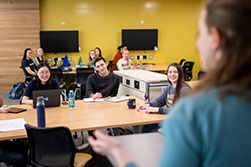 As U-M instructors put the finishing touches on their fall syllabi, many are pondering technology policies for their courses. Instructors across all disciplines at Michigan have developed creative ways to utilize technologies to facilitate student learning. As many U-M faculty examples demonstrate, laptops and mobile electronic devices can be leveraged in the classroom to enhance student interaction, collaboration, content knowledge, and practice with key skills.
As U-M instructors put the finishing touches on their fall syllabi, many are pondering technology policies for their courses. Instructors across all disciplines at Michigan have developed creative ways to utilize technologies to facilitate student learning. As many U-M faculty examples demonstrate, laptops and mobile electronic devices can be leveraged in the classroom to enhance student interaction, collaboration, content knowledge, and practice with key skills.
Yet many teachers find the presence of such devices a hindrance to student learning in their classes and seek ways to limit their classroom use. Recent writings about this concern have cited the distraction of the student user, the distraction of their fellow students (with one faculty commentator comparing classroom laptop use to second-hand smoke), or the sometimes-alarming uses of social media among groups of students during class. Many faculty are also persuaded to limit laptops in the classroom by research on the benefits of notetaking by hand for those students who are able. Considering these concerns alongside the development of ever-better instructional technologies, what's the best technology policy to adopt?
Of course, there is no one-size-fits-all answer to this question, and the choices you make will depend on any number of factors including your discipline, class size, pedagogical strategies, and learning goals for students. Any instructor effectively has three choices, considerations about each of which we outline below:
- Ban laptops and other electronic devices altogether. Many instructors choose to prohibit devices in all circumstances except when students must make use of technology to accommodate a verified disability. (For additional guidance on accommodating student disabilities, see these SSD resources for faculty, and this CRLT webpage.) As with any instructional choice, if you choose to ban computers or phones, it is useful to explain to students the reasons behind your decision. Many teachers share some of the research noted above to explain in terms of student learning their decision to restrict or ban electronic devices. And they underscore its importance by regularly reminding students of the policy at the beginning of class sessions. It is also useful to outline a process in your syllabus for requesting an exception to the policy for valid reasons. U-M Professors Paulina Alberto and Farina Mir use the following language in their History 101 syllabus: "Aside from required iClickers, electronics (cell phones, laptops, iPods, tablets, etc.) are not permitted in lecture or section. Please put them away before class begins. If you must use a computer for note-taking in lecture, you may apply for a waiver to this policy by emailing the professors in the first two weeks of class."
- Allow use of tech devices only under particular conditions. There are a range of options that are not all-or-nothing when it comes to technologies in the classroom. Some teachers, for instance, invite students to use personal devices except when they announce "screens down"; others allow students to use such devices only when they invite "screens up." In large courses, some teachers establish a laptop-free zone in the front of the lecture hall for students who opt to avoid the distraction of others' screens. Some tech policies also make a clear distinction between phones (which are not allowed) and laptops (which are allowed for specific class activities). U-M Associate Professor of American Culture Stephen Berrey uses the following: "Except for an emergency, your cell phones should not be in sight or used in class. Laptops, tablets, and other electronic devices should be used only in conjunction with exercises directly related to class activity. We recognize that laptops can be a useful way to take notes or even to search out additional information. However, inappropriate use—defined as use that inhibits the learning experience for you or for others in the room—is prohibited." As with a policy banning devices altogether, an 'occasional-use' policy requires you to think carefully about how you will enforce it, especially whether you will address infractions with individual students or the whole class.
- Invite students to use their personal discretion as to whether and when to use personal devices. If you make this choice, it is probably still helpful to share some of the most relevant research on distraction and multitasking in order to help students make informed decisions.
 Especially if you choose option 2 or 3, it is important to keep in mind that, while laptops are widely utilized by Michigan students, not every student owns or can afford such a device. You can help build an inclusive campus learning environment by taking care not to communicate an assumption that all students have the same access to or experience with technology.
Especially if you choose option 2 or 3, it is important to keep in mind that, while laptops are widely utilized by Michigan students, not every student owns or can afford such a device. You can help build an inclusive campus learning environment by taking care not to communicate an assumption that all students have the same access to or experience with technology.
As with all of your instructional decisions, CRLT consultants are happy to meet with you to talk through the best technology policy for your particular course. Call us or request a consultation online.
- Log in to post comments
- 78 views






